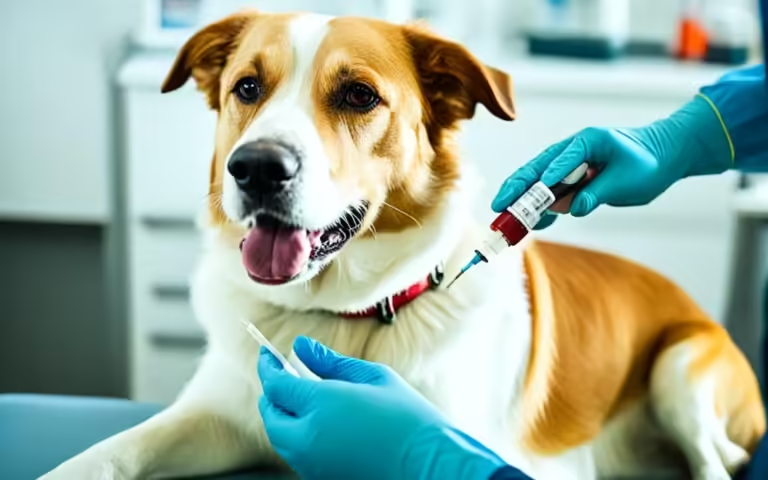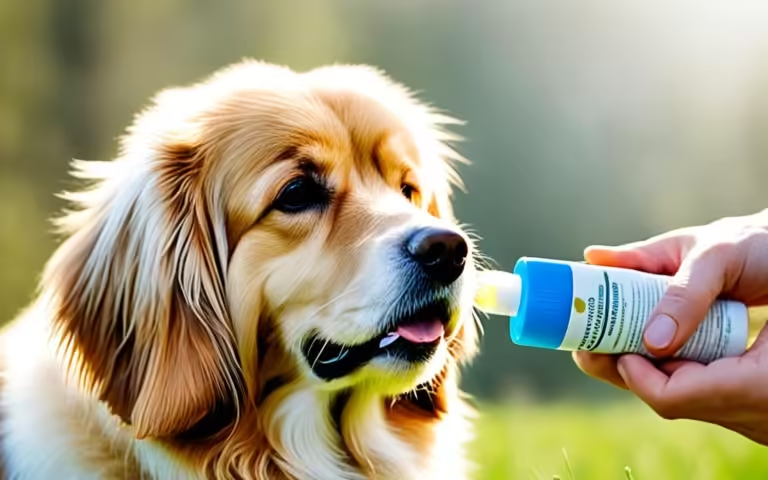Marbofloxacin (Zeniquin®) for Dogs: Antibiotic Guide
Did you know marbofloxacin is a key antibiotic in vet medicine? It treats many bacterial infections in dogs and cats1. Brands like Zeniquin®, Aristos®, Boflox®, and Forcyl® make it a top choice for vets. They use it for urinary tract, skin, and respiratory infections in dogs.
Key Takeaways
- Marbofloxacin is a broad-spectrum fluoroquinolone antibiotic for dogs and cats
- It is commonly used to treat bacterial infections in the bladder, kidneys, skin, and other areas
- Marbofloxacin comes in various brand names and can be administered as a tablet or liquid
- Potential side effects include vomiting, diarrhea, appetite loss, and more serious issues like cartilage abnormalities
- Careful dosing and monitoring is required, especially in young, pregnant, or certain other at-risk pets
Table of Contents
Introduction to Marbofloxacin (Zeniquin®)
Marbofloxacin is a synthetic fluoroquinolone antibiotic used in vet medicine. It’s known by the name 9-fluoro-2,3-dihydro-3-methyl-10-(4-methyl-1-piperazinyl)-7-oxo-7H-pyrido[3,2,1-ij][4,1,2] benzoxadiazine-6-carboxylic acid2. Vets use it for dogs, cats, and other animals like rabbits, reptiles, and birds with special permission.
What is Marbofloxacin?
Marbofloxacin is a powerful antibiotic from the fluoroquinolone group. It works fast to kill bacteria, killing them in 20-30 minutes2. You can give it to dogs orally or on the skin for infections in the skin, lungs, or mammary glands. The usual dose is 2.75 – 5.5 mg/kg once a day2.
Marbofloxacin Brand Names
The brand names for marbofloxacin include Zeniquin®, Aristos®, Boflox®, Forcyl®, Kelacyl®, Marbocyl®, and Aurizon®3. You can buy it in tablets of 25 mg, 50 mg, 100 mg, and 200 mg3. For some infections, you might need to give it for up to 30 days. For urinary tract infections, it’s given for at least 10 days3.
“Marbofloxacin is a broad-spectrum antibacterial agent from the fluoroquinolone class of chemotherapeutic agents.”
How Marbofloxacin Works
Marbofloxacin is the key ingredient in Zeniquin®. It’s a fluoroquinolone that stops bacteria from making DNA during replication4. This makes it a strong choice for fighting many types of bacterial infections4.
Marbofloxacin works by blocking two important enzymes in bacteria: DNA gyrase and topoisomerase IV4. These enzymes help bacteria replicate and divide. By stopping these enzymes, marbofloxacin prevents bacteria from growing and dying4.
Marbofloxacin is especially good at fighting certain bacteria4. It’s been shown to work better than other antibiotics against bacteria from rabbits with respiratory infections4.
Marbofloxacin is easy for dogs and other animals to absorb and use well4. It spreads quickly in the body and gets to where it’s needed, making it a trusted treatment for many bacterial infections4.
“Marbofloxacin is a broad-spectrum bactericidal antibiotic with a high cure rate (about 70%) for naturally-occurring infected dogs when administered at a dosage regimen of 2 mg/kg body weight orally once daily for 28 days.”4
In short, marbofloxacin’s way of working, its antibacterial action, and how it moves through the body make it a top choice for fighting bacterial infections in dogs and other animals.

Marbofloxacin (Zeniquin®) for dog
Zeniquin® tablets with marbofloxacin are approved by the FDA for treating infections in dogs and cats5. They are used for skin infections, wounds, and urinary tract infections caused by certain bacteria5.
Zeniquin® is the main brand for marbofloxacin in the U.S. But, it’s also used in other animals like rabbits, reptiles, and birds6. Vets use it for conditions not listed in the FDA approval, if it’s right for the patient6.
Marbofloxacin in Zeniquin® works well against many bacterial infections in dogs and cats7. It’s absorbed well by dogs, with about 94% being used by the body7. In dogs, about 40% of the dose goes out in the urine. Cats excrete around 70%7.
“Marbofloxacin is a valuable tool in the veterinary arsenal, providing effective treatment options for various bacterial infections in our canine and feline patients.”
Marbofloxacin is usually safe, but vets must think about the right dose and side effects756.
Dosage and Administration
Vets need to think about several things when figuring out the right dosage and how to give Marbofloxacin (Zeniquin®) to dogs. They should give Marbofloxacin orally at a rate of 1.25 mg per lb of body weight every day. If needed, they can up the dose to 2.5 mg/lb86.
Recommended Dosage
For treating skin and soft tissue infections in dogs, give Zeniquin tablets at 2.75 mg/kg once a day for 5 to 14 days8. You can increase the dose to 5.5 mg/kg for a few days after symptoms stop, up to 30 days, if the infection is severe8.
For urinary tract infections, use Zeniquin tablets at 2.75 mg/kg once a day for 10 to 14 days8. If the infection doesn’t get better in 5 days, check the diagnosis again8.
Duration of Treatment
For skin and soft tissue infections, give Zeniquin tablets for 2-3 days after symptoms stop, up to 30 days86. For urinary tract infections, keep giving Zeniquin for at least 10 days86.
Some things can change how much medicine a dog needs, like the type and severity of the infection, how likely the bacteria is to respond, and the dog’s own immune system strength7.

| Infection Type | Recommended Dosage | Duration of Treatment |
|---|---|---|
| Skin and Soft Tissue Infections | 2.75 mg/kg once daily | 5 to 14 days, with the possibility of increasing to 5.5 mg/kg for 2-3 days beyond cessation of clinical signs for a maximum of 30 days |
| Urinary Tract Infections | 2.75 mg/kg once daily | 10 to 14 days |
Pharmacokinetics of Marbofloxacin
Marbofloxacin, found in Zeniquin®, has great pharmacokinetic traits that make it effective9. It gets absorbed quickly and almost fully from the gut, with an AUC of 10.50 ± 2.00 μg·h/mL9. The highest level in blood was between 1.73 ± 0.35 μg/mL and 2.56 ± 0.71 μg/mL9. Its bioavailability of nearly 100% means most of the dose gets into the bloodstream10.
Absorption and Distribution
Marbofloxacin spreads widely in the body, reaching or beating the MIC for many bacteria within 2 hours9. Its broad distribution and deep tissue penetration help it fight a wide range of infections11.
Metabolism and Excretion
Marbofloxacin leaves the body mainly through urine and stool11. About 40% of an oral dose goes straight out in the urine, and the rest gets broken down by the liver11. It takes around 8 hours to half-clear from the body at first, and 3.9 hours by the tenth day, showing quick removal9.
Studies on marbofloxacin have been done on many animals, like dogs, cats, and birds10. These studies help us understand how the drug works in different animals. This knowledge helps set the right doses for treating bacterial infections in pets and farm animals.
| Pharmacokinetic Parameter | Marbofloxacin (Petsen) | Marbofloxacin (Marbocyl) |
|---|---|---|
| t1/2β (half-life) | 22.14 h | 16.47 h |
| Clb (clearance rate) | 0.15 L/h | 0.14 L/h |
| AUC0−∞ (area under the curve) | 13.27 μg.h/ml | 14.10 μg.h/ml |
| Cmax (maximum concentration) | 0.95 μg/ml | 0.97 μg/ml |
| Ke (elimination rate constant) | 0.09 h−1 | 0.11 h−1 |
The table shows how Petsen and Marbocyl marbofloxacin work in beagle dogs10. It shows marbofloxacin’s high absorption and good pharmacokinetics in dogs.
In summary, marbofloxacin has great pharmacokinetic traits. It absorbs fast, spreads widely, and is cleared through urine and stool911. These traits make it effective against many bacterial infections in animals.
Microbiology and Susceptibility
Marbofloxacin, found in Zeniquin®, fights a wide range of bacteria. It works against both Gram-negative and Gram-positive bacteria12. Researchers have tested how well bacteria respond to marbofloxacin. They looked at its effects on skin, soft tissue, and urinary tract infections in dogs and cats12.
Many bacteria are killed by marbofloxacin, including Staphylococcus intermedius, Escherichia coli, and others12. These bacteria are common in dogs and cats. The results show marbofloxacin is effective against these infections12.
Marbofloxacin targets many bacteria, making it a key tool for vets12. Its ability to fight bacteria gives vets a strong option for treating infections in pets12.
Real-world studies also show marbofloxacin works well against tough skin infections in dogs12. These infections are often caused by different bacteria. The studies prove marbofloxacin is effective in treating these infections12.
The data on marbofloxacin’s effects against bacteria shows it’s a versatile treatment for pets12. Vets can trust marbofloxacin (Zeniquin®) to help with many bacterial diseases in their patients12.
Drug Interactions
Marbofloxacin is a fluoroquinolone antibiotic for dogs. It can interact with certain compounds, affecting how well it works13. Things like sucralfate, antacids, and some minerals can be a problem14. These substances can bind to marbofloxacin, making it less effective.
Compounds that Interfere with Absorption
When giving marbofloxacin and these compounds together, be careful13. Try to give them at different times to avoid problems14. Some drugs, like cimetidine and sucralfate, can also affect marbofloxacin15.
Vets should think about these interactions when giving marbofloxacin to dogs131415.
| Compound | Potential Interaction with Marbofloxacin |
|---|---|
| Divalent and trivalent cations (e.g., sucralfate, antacids, mineral supplements) | Can chelate with marbofloxacin, reducing absorption and bioavailability |
| Cimetidine | May decrease the clearance of marbofloxacin, potentially leading to increased plasma concentrations |
| Sucralfate | Can reduce the bioavailability of marbofloxacin, similar to its effects on other fluoroquinolones |
| Ketoconazole | May interact with marbofloxacin, potentially leading to increased drug concentrations and toxicity |
“Careful consideration of potential drug interactions is crucial when prescribing marbofloxacin to ensure the optimal therapeutic effectiveness and safety for canine patients.”
Vets should watch for any signs of less effectiveness or side effects when using marbofloxacin with other drugs131415.
Contraindications and Precautions
Marbofloxacin (Zeniquin®) is a strong antibiotic that needs careful use in some cases16. It belongs to the quinolone class of drugs. This type of drug can harm the joints and cartilage in young animals that are growing fast.
Marbofloxacin is not recommended for small and medium dogs until they are 8 months old3. For large and giant breeds, wait until they are 12 and 18 months old, respectively3. Cats under 12 months should also avoid this antibiotic8.
Age Restrictions
Vets must be careful when giving marbofloxacin to young pets3. This antibiotic can cause permanent harm to their joints and cartilage. This harm can affect their growth and how well they move.
Other Precautions
Marbofloxacin also needs careful use in pets with seizures, liver or kidney issues, or dehydration8. It’s not safe for pregnant or nursing animals either8.
It’s important to watch the patient closely when using marbofloxacin8. Vets must think about the risks and benefits for each patient.
Potential Side Effects
Marbofloxacin can cause side effects, especially in the stomach, leading to vomiting, diarrhea, and less appetite13. Serious issues like joint problems, lack of appetite, and seizures are also possible1. Cats might face blindness and eye issues with high doses13.
Marbofloxacin can make seizures worse in those prone to them, especially if they have liver or kidney problems13. It also makes skin more sensitive to the sun, so pets should avoid the sun too much1.
Marbofloxacin comes in different sizes, but the usual dose for pets is 2.75 to 5.5 milligrams per kilogram of body weight daily17. Taking too much can harm the nervous system17.
Be careful with young pets when giving them marbofloxacin. Puppies and kittens need special care to avoid joint damage13. Cats and dogs under certain ages should be watched closely1.
Don’t give marbofloxacin to pregnant or nursing pets, or those with seizure disorders or liver or kidney issues1. Also, be aware of interactions with other medicines13171.
In conclusion, marbofloxacin is a useful antibiotic for dogs, but we must watch out for side effects to keep our pets safe13171.
Monitoring and Storage
When giving marbofloxacin (Zeniquin®) to dogs, there’s no need for special checks18. Yet, vets will keep an eye on the pet to make sure it works well and to spot any side effects18. This medicine can cause joint problems in young animals, especially dogs18.
Keeping marbofloxacin in the right place is key to its effectiveness. Zeniquin® tablets should be stored in a sealed, light-proof container at a cool temperature18. For liquids, just follow the bottle’s storage advice, which might mean keeping it in the fridge18.
It’s vital to use marbofloxacin carefully to avoid making bacteria resistant to antibiotics18. Vets should watch how the pet reacts to the treatment and make sure it’s used right18.
Storing and handling marbofloxacin (Zeniquin®) correctly is key to its safety and effectiveness. By following the right storage tips and watching the pet’s response, both pet owners and vets can make the most of this antibiotic. This helps reduce the chance of bad effects or antibiotic resistance18.
Conclusion
Marbofloxacin (Zeniquin®) is a key antibiotic for dogs and cats. It fights many bacterial infections, including skin, soft tissue, and urinary tract infections19. The tablets come in different strengths for a tailored treatment plan19.
Studies have looked into how marbofloxacin works in dogs19. They found the best ways to give it to dogs for the most effect19. Also, it has been tested against many dog infections and works well19.
Marbofloxacin is usually safe but watch out for side effects, especially in young animals or those with health issues19. Knowing how to use marbofloxacin helps vets treat bacterial infections in dogs well19.
FAQ
What is marbofloxacin?
What are the brand names for marbofloxacin?
How does marbofloxacin work?
What are the approved indications for marbofloxacin (Zeniquin®) in dogs and cats?
What is the recommended dosage of marbofloxacin (Zeniquin®) for dogs?
How is marbofloxacin absorbed and eliminated in dogs and cats?
What is the antibacterial spectrum of marbofloxacin?
What compounds can interfere with the absorption of marbofloxacin?
What are the contraindications and precautions for using marbofloxacin in dogs and cats?
What are the potential side effects of marbofloxacin in dogs and cats?
How should marbofloxacin tablets and liquid formulations be stored?
Source Links
- Marbofloxacin | VCA Animal Hospitals
- Marbofloxacin
- Marbofloxacin (Zeniquin®) for Dogs and Cats
- Marbofloxacin – an overview | ScienceDirect Topics
- Zeniquin Antibiotic For Dogs & Cats 100mg, 50 Tablets
- Zeniquin 25 mg (sold per tablet) | 1800PetMeds
- Zeniquin® (marbofloxacin)
- Zeniquin Antibiotic For Dogs & Cats 50mg, 250 Tablets
- No title found
- Evaluation of Marbofloxacin in Beagle Dogs After Oral Dosing: Preclinical Safety Evaluation and Comparative Pharmacokinetics of Two Different Tablets
- No title found
- Investigation of In Vitro Susceptibility and Resistance Mechanisms in Skin Pathogens: Perspectives for Fluoroquinolone Therapy in Canine Pyoderma
- Marbofloxacin (Zeniquin)
- Zeniquin for Animal Use – Drugs.com
- 40027358
- Marbofloxacin in Veterinary Medicine – Facts and Information | PetCoach
- Zeniquin 100mg Tablets
- NADA 141-151







